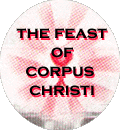| |
The Theology & Symbolism
of the Corpus Christi Procession

The Corpus Christi Procession. The importance
of such a ritual gesture cannot be underestimated, for it involves
bringing God literally into the community, through the streets and
passages where people live and work. It is a literal, not symbolic,
ritual that sacralizes common space and echoes the mystery of Catholic
incarnational theology: the Word was made flesh and dwelt among
us. The Feast of Corpus Christi reminds the faithful that the quarantining
of the Sacred within the church structure (a common feature of Reformation
Protestant theology) is impossible. This theological ritual insists
that God erupts amidst and dwells among us.
* View Images of the Corpus Christi
Procession
The Eucharist. The Constitution on the
Sacred Liturgy begins Chapter 2, "The Most Sacred Mystery
of the Eucharist," with the following:
"At the Last Supper, on the
night when he was betrayed, our Savior instituted the Eucharistic
sacrifice of his Body and Blood. This he did in order to perpetuate
the sacrifice of the Cross throughout the ages until he should come
again, and so to entrust to his beloved Spouse, the Church, a memorial
of his death and resurrection: a sacrament of love, a sign of unity,
a bond of charity, a paschal banquet in which Christ in consumed,
the mind is willed with grace, and a pledge of future glory is given
to us." [1323, 1398]
The Eucharistic celebration is a holy meal which recalls the
Last Supper. In the Eucharist, Christ the Lord nourishes Christians,
not only with His word but especially with His Body and Blood,
effecting a transformation which impels them toward greater love
of God and neighbor. The Holy Sacrifice of the Mass is the perpetual
sacrifice of the New Covenant in which the Sacrifice of the Cross
is made sacramentally yet truly present.

Some Eucharistic texts adapted from St. Joseph
Catholic Manual, Catholic Book Publishing Co., 1994 & Handbook
for Today's Catholic, Liguori Publications, 1994.
|